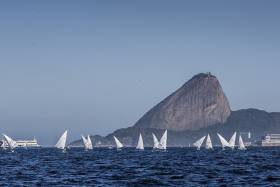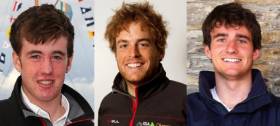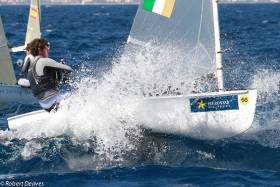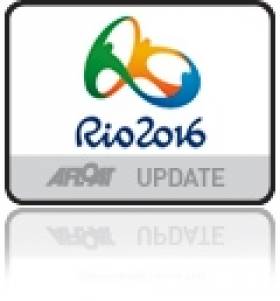Displaying items by tag: Olympic
Olympic Sailing Team – Two Months to Improve Before Rio
After a weekend of poor Irish performances at the British round of the Sailing World Cup, the Irish Sailing Association has acknowledged results from Weymouth were 'far from ideal'.
The Sailing World Cup on the Dorset coast, billed as the 'final opportunity for sailors to lay down a marker before the Rio 2016 Olympic Games', was attended by 380 Olympic sailors from 44 nations.
Men’s skiff sailors Ryan Seaton and Matt McGovern from Belfast reached the medal race final which they led for its entirety before sailing the wrong course to the finish line.
London 2012 veteran Annalise Murphy, Ireland’s most successful sailing athlete in the last 30 years, had one of her most disappointing results of the season when she placed 34th in the 39–strong Laser Radial fleet. Murphy has been concentrating on preparations for her second appearance at the games but the Rio venue offers much lighter winds to four years ago when she narrowly missed a podium result.
Andrea Brewster and Saskia Tidey in the women’s skiff placed last in the 49erFX event.
“We have two months to focus on the things we can improve before starting the Olympic regatta in Rio', Team Manager James O'Callaghan said yesterday.
Men’s single-hander Finn Lynch, the youngest ever Irish helm to be selected for Team Ireland did not take part in the regatta due to training-camp commitments in Croatia.
The 49er pair have one further regatta at Kiel Week in Germany later this month before final preparations begin for their second Olympic appearance at Rio 2016 in August.
The first race in the Rio 2016 regatta begins on Monday 8th August when Murphy and Lynch begin their respective events.
A facebook campaign update from the 49er crew:
The conclusion of the Laser Radial trials and Annalise Murphy's Rio selection yesterday means three of the four Irish qualified sailing disciplines for Rio have now been decided. The Men’s single-handed event in the Laser Standard rig will have the final trials event at the World Championships next month, also in Mexico.
London 2012 veteran James Espey from Ballyholme YC holds a narrow lead over Murphy's club–mate Finn Lynch from the National YC. Baltimore’s Fionn Lyden is also a contender.
The points difference heading into the final trial is as follows:

Along with Annalise, 49er sailors Ryan Seaton with Matt McGovern and 49erFX sailors Andrea Brewster with Saskia Tidey await ratification by the board of the ISA to be nominated to the OCI for inclusion in the national team for Brazil.
Donaghdee's Oisin McClleland Crashes Through Palma Waves
Northern Ireland sailor Oisin McClleland makes a splash on the cover of the latest Finn newsletter. The Donaghdee dinghy helmsman is aiming for the 2020 Olympics in Tokyo and has been part of a crowd–funded campaign to introduce more nations to the heavyweight Olympic dinghy. In its opening photo by Robert Deaves this morning, McClleland crashes through a wave in Palma at the Trofeo Princesa Sofia Regatta.
Meanwhile, the Finn Class line up for the 2016 Olympic Games is nearly complete. There will be on Irish representation for 2016. Ireland's last Olympic representation in the class was David Burrows in 2004 in Athens and Timothy Goodbody in Qingdao 2008.
The country qualifiers are over and now it is about national selection and taking up of places.
GBR, CRO, FRA, NZL, USA, NOR, SWE, DEN, SLO, AUS, HUN and FIN qualified in Santander in 2014. NED, GRE, EST and URU qualified in Takapuna 2015. ITA qualified from the Takapuna result as there was no new Oceania nation present in Melbourne. CHN qualified from the Asian qualifier in Qingdao. ARG and CAN qualified for the continential places for North and South America at the Sailing World Cup Miami in January. Finally at the last continental qualifier in Palma, TUR won the European place and SEY won the African place. A lot of battles along the way but 23 nations with a ticket to Rio.
The World Sailing executive has now received the interim report on the situation concerning the participation and conditions placed on Israeli sailors for the Youth Sailing World Championships in Malaysia.
World Sailing has demanded an immediate full explanation from both the Malaysian and Israeli Sailing Organisations (Member National Authorities) on this issue.
World Sailing stands by its commitment to both the Olympic ideals and ensuring that competitions taking place under the auspices of World Sailing permit all sailors to represent their country and to compete fully and equally. World Sailing has always taken this issue very seriously and undertakes to clarify and strengthen this requirement of all future World Sailing event organisers, if required, once the full report is concluded.
With regards to the current situation with Israel and Malaysia, World Sailing whilst adamant that the situation is not acceptable under the above principles, acknowledges that delays in communication by both Israeli and Malaysian officials in the lead up to the regatta have contributed to the situation spiralling into the current controversy. This is something that could have been prevented and will be actively managed in the future. World Sailing only learnt of Israel's withdrawal on 24 December, with immediate action taken to obtain factual information on the ground in Malaysia and to respond appropriately to this challenging situation.
These diplomatic issues are faced by all sports of this nature. World Sailing cannot solve all such problems, but as an organisation it, and its members can work towards acceptance of all nations and towards finding suitable solutions within the current political arena. As a result of this, World Sailing shall strengthen its processes to prevent discrimination within the sport.
World Sailing had the full support of the International Olympic Committee (IOC) during the build up to the Youth Worlds and will continue to enlist their help and expertise in this matter.
Further information on the report and the proposed actions will be provided after the emergency Executive Committee meeting on the 8 January.
Confusion Over Murphy's Results, Lynch Leads Irish Olympic Laser Mens Trial After Day One in Rio
Offical results from the first rounds of the Irish Olympic Sailing Laser Trials in Brazil appear to show an inauspicious start for Annalise Murphy at Ill Copa Brazil de Vela. According to the official scoresheet (downloadable below), Murphy 'did not compete' in the first day of competition yesterday and is recorded in last place but the Irish Sailing Association (ISA) say this is not the case.
Murphy did race yesterday and the DNCs shown on the scoresheet are the result of a 'scoring error', according to the ISA. Irish team manager James O'Callaghan says Annalise scored 'about a 20 and 13'. The official results have yet to be updated by organisers to reflect this position.
Howth Yacht Club 17–year–old Aoife Hopkins who is contesting the single irish Rio place scored a 28 and a 20 in the opening races to be 23rd overall in the 38–boat fleet.
Racing starts today So excited ! Proud to be part of team CH Marine and ISA Performance Youth Academy
Posted by Aoife Hopkins Sailing on Tuesday, 15 December 2015
Winds were light, below ten knots, for the first day of competition at the Ill Copa Brzail de Vela venue.
At the top of the women's fleet, the world's top Radial sailors occupy the first three places with Evi Van Acker of Belgium leading on six points, Holland's Marit Boumeester one point behind in second place and Danish champion Anne–Marie Rindom third.
In the mens division, a 19 and 30 scored in the 46–boat fleet puts the National Yacht Club's Finn Lynch in 21st overall and eleven places clear of Fionn Lyden of Schull Harbour Sailing Club in 32nd with Belfast's James Espey in 36th place. Download results below.
Racing continues today with eight more races left to sail. The Irish 49er and 49erfx skiff crews are also competing.
Irish Olympic Sailing Laser Trials Under Way in Rio
In spite of qualifying the nation for Rio 2016, both London 2012 Laser sailors Annalise Murphy and James Espey face a test for their Olympic places on Rio waters this afternoon. The first of three Irish Olympic sailing trials begins at Copa Brasil De Vela regatta and three young Irish pretenders (from an earlier possible shortlist of eight) seek to unseat Murphy and Espey for the two Rio berths available.
In the Womens Laser Radial class, Aoife Hopkins threw down the gauntlet to Irish sailing sensation Murphy a month ago. The Howth Yacht Club backed 17–year–old declared for the Radial trial in an ambitious campaign that's ultimate aim is a medal in Tokyo 2020.
In the mens division, Belfast's Espey comes up against ISAF silver medalist Finn Lynch and West Cork's Fionn Lyden. At one stage there was arguably two more would be contenders but both Seafra Guilfoyle of Royal Cork and Daragh O'Sullivan of Kinsale ruled themselves out of the costly trials series. The build up to the trials has not been without its own drama when the National Yacht Club's Lynch dislocated a shoulder a month ago.
Hanging around waiting for wind?
Posted by James Espey Sailing on Monday, 14 December 2015
Both mens and womens Laser divisions will race ten races with a single discard on the Olympic waters and the forecast is for winds of less than eight knots after some stormy weekend weather.
Racing begins at 1pm local time, two hours behind GMT. The NOR is downloadable below.
The Irish Sailing Association coach Rory Fitzpatrick and the ISA's Olympic Sailing Group member Trevor Millar, (who is Founder and Executive Director of the Laser coaching service, Sailcoach Ltd ) are monitoring the Irish trial.
Despite strong winds and rain that hammered Rio at the weekend the race progamme is going ahead without amendments, even though there a reports of increased pollution in the bay.
The competiton runs until 20 December and will be based in San Francisco beach in Niteroi, and will be used used by the host nation to fill the remaining spots of the Brazilian Sailing Team in the Olympics.
An event website is here with no entry list available. Twitter followers are using # vempravela #agoraébra.
After Copa Brasil de Vela, the Irish trial continues with the 2016 ISAF Sailing World Cup Miami, and the 2016 Laser Radial World Championships (Women) and the 2016 Laser World Championships (Men).
ISAF AGM To Hear Portuguese Proposal to Disband Council
As the world governing body for sailing, ISAF, sits down to its annual powwow this week in China it is in the knowledge that it intends sticking to plans to hold races in next year’s Summer Olympics inside highly polluted Guanabara Bay.
But polluted Olympic waters is by no means the only embarrassment on the table for the blazers attending in Sanya.
The fundamental governance structure of ISAF is in question, with a proposal from Portugal to disband Council to be considered at the AGM. The remote and costly nature of this year’s meeting in Sanya has resulted in a smaller than usual turnout of smaller nations who might support this move.
The woes of the Sailing World Cup will also be discussed, with rescue proposals being placed on the agenda by ISAF, who acknowledged that 'the Final is a long way from being a compelling event that attracts top sailors'. In this year’s final two classes were cancelled for lack of entries, one class had only six boats and only two classes attracted the full complement of 20 boats.
Also, the decision by the International Paralympic Committee (IPC to drop sailing from the Paralympic Games programme in 2020 has galvanised ISAF into a rearguard action to prove to the powers that be that sailing merits its place. Afloat.ie will have more on this.
#rio2016 – Just over a year before the Rio Olympics Sailing Regatta, the much anticipated 2016 Olympic Games Sailing Nomination Procedures has been published by the Irish Sailing Association (downloadable below).
A real dilemma for selectors has been the men's Laser class. Belfast's James Espey (31) did Ireland a great service in qualifying the country at the first attempt. The selectors have been aware that two years can make a difference to the development of younger sailors, suggesting that recent Youth World silver medalists Finn Lynch (19) and Seafra Guilfoyle (18) will come into the selection mix. Espey's age and performance profile suggest, that while he could triumph in an unambiguous trials format selectors have decided Irish sailing might be better served by looking to the future, especially as the talent glass in this class is more than half full.
It looks like early selection in the Laser Radial and 49er class has not been too hard a decision for the ISA. Any significant competition to the Rio nation qualifying sailors has not materilaised, and this removes the uncertainty of a trial series. This can bring benefits to the performances of Annalise Murphy (25), Ryan Seaton (26) and Matt McGovern (28), allowing them to build a programme focusing on podium positions at major events. Funding, coaching and athlete needs support can be built around this model. In the case of Murphy, in particular, improving performance in light air conditions is a must if Ireland is to improve on its 2012 result in Weymouth.
In the nomination procedure, the ISA sets out a trials series for the Laser standard class (men) and notes that apart from the Laser standard, a trial will only take place in another class if more than one candidate meets a minimum standard. For the Laser Radial this is top 60% at the Oman Laser Worlds later this year. According to the criteria, if a trial is needed the entry will be open to all candidates.
So far Ireland has secured nation qualification for Rio in the Laser, Laser Radial and the 49er dinghies. A campaign for a fourth slot in the women's 49erfx is currently underway.
In the 49erFX, selection has to await country qualification, but this should be a formality given recent top performances by Brewster and Tidey. Their performance may have inspired other young sailors to up their game and pose a challenge for them even late in 2015 or is such a prospect now too remote?
The Trial Regattas for Laser and Laser Radial shall be, 2015 Copa Brasil de Vela, 2016 ISAF Sailing World Cup Miami, and the 2016 Laser Radial World Championships (Women) and the 2016 Laser World Championships (Men)
The Trial Regattas for 49er and 49erfx shall be, 2015 Copa Brasil de Vela, 2016 ISAF Sailing World Cup Miami, and the 2016 49er and 49erfx World Championships
Full details downloadable below.
#isafworldcup – A satisfying medal race finish is in store this morning at 11.45 for Annalise Murphy whose hard work paid off yesterday when she took a 9,1,5 to be fourth overall and four points off the Bronze medal position currently held by Britian's Alison Young.
The positions for this morning's live Medal Races have been decided following an intense day of competition at ISAF Sailing World Cup Weymouth and Portland yesterday.
After Friday only served up a race apiece for the Men's RS:X and 470, Saturday was always going to be a hard day with an additional race for each fleet added.
A 13-17 knot breeze coupled with a lumpy sea state tested the competitors with the leader boards fully shaped for the live Medal Races which will be available to view here from 11:00 local time
The Irish Sailing star will be hoping to move up one place and improve on her Olympic sailing Regatta result three years ago. Critically though, the forecasted breeze is only 8 knots from the north-west, potentially leaving Annalise without her heavy air boat speed advantage.
Marit Bouwmeester (NED) has been head and shoulders above her 35 other rivals in the Radial.
From seven races Bouwmeester counts five bullets and two seconds, an outstanding collection of results that has only been bettered by Great Britain's Helena Lucas (GBR) in the Paralympic 2.4mR event.
Bouwmeester was unlucky not to make it a clean sweep of race victories on the penultimate day of racing. She took the first race victory with a certain degree of comfort, finishing 19 seconds ahead of Anne Marie Rindom (DEN).
In the next race she took an early lead but relinquished the spot to Annalise who finished 19 seconds ahead. Bouwmeester led the third and final race of the day from the beginning but was passed by Evi Van Acker (BEL). Very little separated the pair as the race played out and the Belgian took the bullet by just seven seconds.
Murphy & Espey Lead Irish at Delta Lloyd Regatta
#saildlr – A forecast of strong winds looks set to sweep Annalise Murphy to the the top of the fleet in Medemblik this week and assure her of the single Irish place at the Olympic test event in Rio in August. Already the Dun Laoghaire solo sailor has made the gold fleet, curently in fifth overall, clear head of four other Irish rivals in her 82–boat fleet. Likewise Belfast's James Espey in the mens division is counting four top ten results after another solid day yesterday with a seventh and a seventh to put him eighth overall, critically he's placed in the gold fleet with discard still intact. He leads four other Irish trialists.
Also competing in Medemblik for just two places at Aqueece Rio, Brazil are radial saiors Aisling Keller, Aoife Hopkins, Erica Ruigrok and Nicole Hemeryck. Irish Laser men competing are Fionn Lyden, Chris Russell, Finn Lynch and Darragh O'Sullivan.
































































